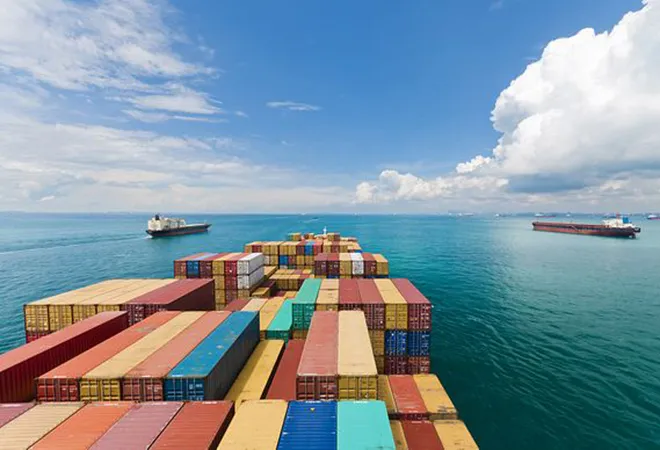-
CENTRES
Progammes & Centres
Location
India and Australia can support the development of a Single Window System in fellow Indian Ocean Region states for trade facilitation at the regional level

This piece is part of the series, India–Australia Partnership: The Defence Dimension
The Indian Ocean Region (IOR) is an important area for global trade, connecting the continents of Asia, Africa, and Australia, and playing a critical role in the flow of goods and resources around the world. According to estimates, half of the world's container ships, one-third of the bulk cargo traffic, and two-thirds of the world's oil shipments pass through the IOR. However, the region is also facing several challenges, including piracy, illegal fishing, and security threats, which can disrupt trade supply chains and undermine the region's economic growth. In response to these challenges, many countries in the IOR are working to enhance Maritime Domain Awareness (MDA) and improve the safety and security of the region's shipping lanes. One of the ways this is being done is through digital collaborations such as the development of a Single Window System (SWS) for trade facilitation at both national and regional levels. In the IOR, India and Australia have developed significant capacities to support the development of this system in fellow IOR states.
Single Window System in the IOR
An SWS is a digital platform that facilitates trade by enabling all necessary information and documents for export and import (EXIM) to be submitted through a single-entry point. The objective is to streamline customs/regulatory procedures, improve information flows, and enhance the efficiency and transparency of trade transactions. It brings multiple stakeholders—ports (sea and land), customs, traders, shipping lines, financial institutions, etc.—on a common platform for real-time information exchange. This eliminates the need to provide duplicative information to multiple agencies and reduces the time and cost of trade.
An SWS is a digital platform that facilitates trade by enabling all necessary information and documents for export and import (EXIM) to be submitted through a single-entry point.
The IOR, which includes several countries with important ports and supply chain hubs, can greatly benefit from such a regional SWS by streamlining trade, increasing global competitiveness, and securing sea lines of communication. It would create a seamless and efficient trade environment in the IOR, which would drive economic growth, job creation, and regional integration.
Several countries in the region are invested in developing both national and regional SWS. For instance, the Maldives is being assisted by the Asian Development Bank (ADB) to develop a national SWS. In 2022, the Indian Ocean Commission, too, focused on developing a regional maritime single window system for trade facilitation and enhancing MDA.
Finding a role for India and Australia
Both India and Australia are well-placed in the IOR to share their best practices and contribute towards the development of a regional SWS.
As global trade started to adopt technology towards streamlining practices, India has transitioned to digital platforms for trade transactions with the goal of improving the ecosystem and facilitating trade through digitisation and information exchange. The Customs ICEGATE (Indian Customs Electronic Commerce/Electronic Data Interchange Gateway), maintained by the Central Board for Indirect Taxes and Customs, Ministry of Finance, provides services such as risk management, shipping bill submissions, generation of electronic bills of lading, and duty payment, amongst others. The system has improved cross-border trade data management and analysis and has helped the country enhance its trade environment for ease of doing business by bringing all stakeholders on board.
This was one of the factors that contributed to India's improved score in the UN Global Survey on Digital and Sustainable Trade Facilitation, from 78.49 percent in 2019 to 90.32 percent in 2021. Similarly, at India’s land ports, for instance, the time taken for trucks to cross the India-Bangladesh border from the Petrapole Integrated Check Post has reduced from five days to one day.<1> To further improve logistics efficiency, reduce EXIM costs, and increase trade predictability, India is now developing an API-based Unified Logistics Interface Platform to include more stakeholders and enhance data sharing.
The system has improved cross-border trade data management and analysis and has helped the country enhance its trade environment for ease of doing business by bringing all stakeholders on board.
India's efforts to improve the trade and supply chain ecosystem through digitalisation and information exchange could be complemented by Australia in the region by developing a regional SWS. Australia has its own experience in the development of such systems, as demonstrated by its Integrated Cargo System (ICS), which was created in 2004 and communicates with multiple Australian departments and agencies.
Australia also has experience in cross-border data exchange streamlining, as evidenced by the launch of the Secure Trade Lane in 2017, in collaboration with New Zealand for containerised trans-Tasman sea cargo. The Secure Trade Lane uses supply chain security through Mutual Recognition Agreements and streamlines border clearance processes by using the digital information sent by the exporters. These initiatives demonstrate Australia's ability to contribute to the development of a regional SWS, which could have a positive impact on securing trade supply chains.
Building a regional SWS
There are several levels of interventions required for developing a regional SWS. This includes establishing a clear legal framework, service-level agreements with partner countries or the region, data harmonisation, and stakeholder collaborations.
First, in terms of the legal framework, several IOR countries have ratified the World Trade Organisation’s Trade Facilitation Agreement and are developing a national SWS. They are also signatories to the International Maritime Organisation’s FAL convention that enables data sharing by shipping lines across ports to enhance risk management. In IOR countries, where the legal framework is streamlined, it will be easier for both India and Australia to enter into SWS projects and develop a harmonised framework for a regional SWS. In countries where the legal frameworks are yet to be implemented, both India and Australia can support the development of this system through technical programmes. At a bilateral level, this can also be done through India’s Indian Technical and Economic Cooperation (ITEC) programme as part of India’s development assistance or the Australian Agency for International Development.
The Secure Trade Lane uses supply chain security through Mutual Recognition Agreements and streamlines border clearance processes by using the digital information sent by the exporters.
Second, India, Australia, and the smaller IOR islands can sign a service-level agreement (bilateral, trilateral, or regional-level) for building an SWS and engage in capacity enhancement for data management, harmonisation, and exchange. This would also need a strong institutional platform to back this system to ensure transparency and data security. Regional institutional platforms such as the Indian Ocean Rim Association or the Indian Ocean Commission can potentially oversee the overall management of the system. This could also be made part of the India-Australia-Japan Supply Chain Resilience Initiative.
Finally, beyond the technical interventions, successful implementation of a regional SWS will require concentrated efforts at various levels—governments, security establishments (border guards, navy, coastal security), the trade fraternity, and the private sector. The development and management of the SWS requires political trust and a long-term commitment to safeguarding trade routes to promote economic development. This can also be achieved through the organisation of joint trade facilitation and border management meetings at different levels.
Riya Sinha is an Associate Fellow at the Centre for Social and Economic Progress.
This article was written as part of the Australia India Institute’s defence program undertaken with the support of the Australian Department of Defence. All views expressed in this article are those of the author only.
<1> Based on the author’s field survey.
The views expressed above belong to the author(s). ORF research and analyses now available on Telegram! Click here to access our curated content — blogs, longforms and interviews.

Riya Sinha is an Associate Fellow at the Centre for Social and Economic Progress.
Read More +